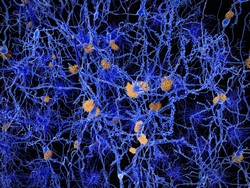Neuronal networks in Alzheimer's disease
Processing and storage of information processing by brain networks requires a highly coordinated operation of multiple neuronal groups. In particular, the rhythmic activity of neuronal populations gives rise to oscillations that in turn mediate memory consolidation. Oscillations of different frequency (theta and gamma) occur in the same brain regions and interact with each other, a phenomenon known as cross-frequency coupling. Accumulating evidence indicates that the magnitude of the coupling is positively associated with cognitive processes in humans. The scope of the EU-funded OSCILL_A (Non-amyloid-related hippocampal network dysfunction as an early biomarker of Alzheimer’s disease) project was to understand how cross-frequency coupling is altered in Alzheimer's disease. Previous work in a mouse model of AD had shown an inverse correlation between hippocampal cross-frequency coupling and β-CTF levels, the immediate precursor of Aβ peptides. The ultimate goal of the OSCILL_A study was to demonstrate that β-CTF represented the first hazardous step in the amyloid cascade. Using young AD mice before the onset of brain plaques, researchers observed early behavioural alterations only in a subset of hippocampal-dependent tasks. These specific memory impairments were likely related to alterations in hippocampal inhibitory networks with different amyloid precursor protein (APP) metabolites being responsible for specific cognitive deficits. Considering that in AD patients, signs of memory impairments may arise more than 10 years before the diagnosis of the disease, cross-frequency coupling alterations could represent an early biomarker. This could be evaluated using a non-invasive technique such as high-density EEG. To this end, researchers went on to analyse clinical EEG recordings and validate the existence of cross-frequency coupling in young subjects and in high-performing seniors. Any deterioration in coupling was directly associated with ageing and cognitive performance. Since prevention is currently the best strategy against dementia, the systematic characterisation of the coupling state in patients with a mild cognitive impairment may improve their condition. It will lead to combinatorial therapeutic approaches based on mental and physical activity together with AD therapeutics.







